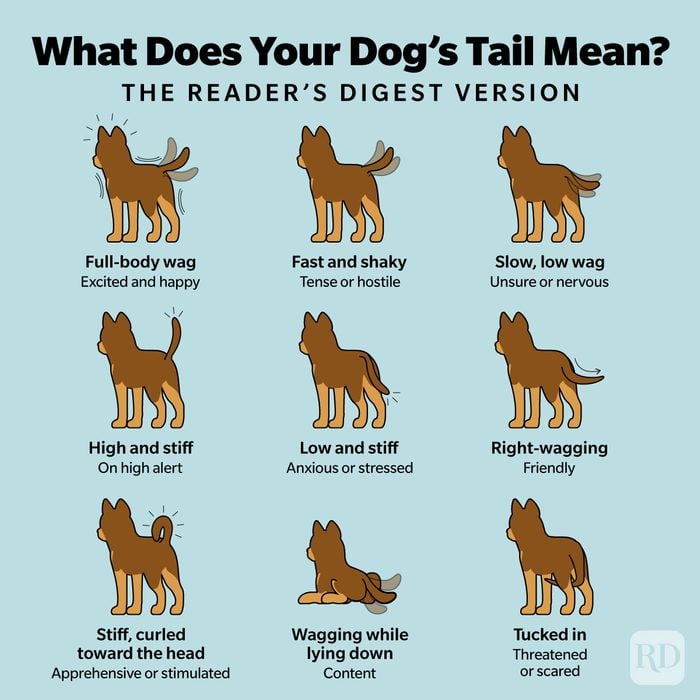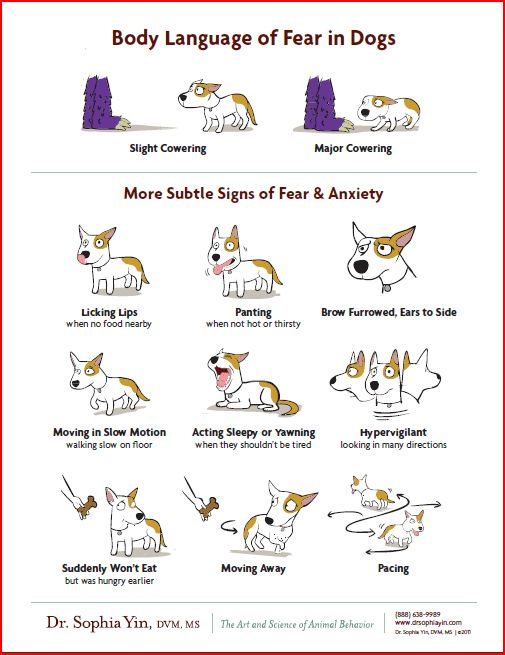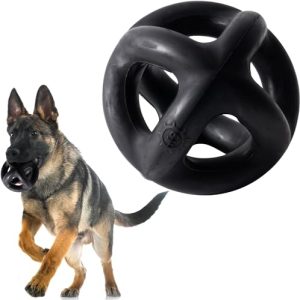Have you ever wondered what your dog is really trying to tell you? Dogs communicate mostly through their behavior, but if you don’t know the signs, important messages can be missed.
Understanding your dog’s behavior signs can help you build a stronger bond, keep them happy, and avoid problems before they start. You’ll discover the key signals your dog uses every day and how to respond to them. Pay close attention—you might be surprised by what your furry friend has been trying to say all along.

Credit: www.rd.com
Common Dog Body Language
Dogs use their bodies to show how they feel. Watching their movements helps us understand them better.
Body language can tell if a dog is happy, scared, or curious. Learning these signs keeps dogs and people safe.
Tail Movements
A dog’s tail shows many emotions. A wagging tail usually means friendliness. A stiff tail can mean alertness or nervousness.
- High and wagging: happy and confident
- Low and wagging: submissive or unsure
- Stiff and raised: alert or aggressive
- Tucked between legs: scared or anxious
Ear Positions
Ear positions help show a dog’s mood. Ears up mean attention. Ears back may show fear or submission. Relaxed ears indicate calmness.
| Ear Position | Meaning |
| Ears up and forward | Alert and interested |
| Ears laid back | Fear or submission |
| Ears relaxed | Calm and content |
| One ear up, one down | Curious or unsure |
Eye Expressions
Dogs use their eyes to communicate. Soft eyes show trust. Hard stares may warn of aggression. Avoiding eye contact can mean fear or stress.
- Soft eyes:relaxed and friendly
- Hard stare:warning or challenge
- Averted gaze:nervous or submissive
- Wide eyes:surprise or fear
Posture And Stance
A dog’s posture shows its feelings clearly. Standing tall means confidence. Crouching or lowering the body shows fear or submission.
- Relaxed stance: calm and comfortable
- Rigid stance: alert or tense
- Crouched body: scared or submissive
- Raised hackles: fear or aggression

Credit: www.yahoo.com
Vocal Signals Dogs Use
Dogs communicate with us using various vocal signals. Understanding these signals helps us know what they need or feel.
Each sound they make has its own meaning. It’s important to learn what these sounds mean.
Barking Patterns
Barking is the most common sound dogs make. It can mean different things based on the pattern.
Short, repeated barks can mean they see something. Long, continuous barking may mean they are bored or anxious.
Whining And Whimpering
Whining is a sound dogs make when they want something. It can also mean they are scared or uncomfortable.
Whimpering is similar but softer. It usually means they are sad or seeking attention.
Growling And Snarling
Growling is a warning sound. It tells others to stay away or stop what they are doing.
Snarling is more intense than growling. It often shows the dog feels threatened or is protecting something.
Howling And Yelping
Howling is a sound dogs use to communicate over long distances. It can mean they are lonely or trying to find someone.
Yelping is a sharp, high-pitched sound. It usually means they are in pain or surprised.
Signs Of Stress And Anxiety
Dogs show stress and anxiety in many ways. Recognizing these signs helps owners provide support.
Stress affects a dog’s health and behavior. Look for changes in actions or body language.
Pacing And Restlessness
Pacing is a common sign of stress in dogs. They may walk back and forth without rest.
Restlessness can include shifting weight, whining, or inability to settle down. These show discomfort.
Panting And Drooling
Heavy panting and drooling may happen even when a dog is not hot or thirsty. This shows anxiety.
- Rapid breathing
- Excess saliva
- Open mouth without exercise
- Tongue hanging out often
Avoidance Behaviors
Dogs may hide or avoid people and places when stressed. They want to escape what causes fear.
| Behavior | Description |
| Hiding | Seeking quiet or dark spots |
| Turning Away | Looking away from a person or object |
| Refusing to Eat | Loss of appetite due to stress |
| Shaking | Shivering or trembling without cold |
Destructive Actions
Stress can cause dogs to chew or scratch furniture and doors. They act out their anxiety physically.
Common destructive behaviors include:
- Chewing shoes or clothes
- Scratching doors or walls
- Digging in the yard
- Breaking household items
Indicators Of Happiness And Comfort
Dogs show their feelings through body language and actions. Watching these signs helps you understand if your dog feels happy and safe.
Recognizing comfort signals can improve your bond. Happy dogs are easier to train and care for.
Relaxed Body Movements
A calm dog moves smoothly and without tension. Their muscles are loose, and they do not seem stiff or tight.
Signs include a wagging tail at a gentle pace and a loose stance. They may lie down comfortably or stretch out.
- Soft, wagging tail
- Relaxed ears and body
- Gentle, slow movements
- Comfortable lying or sitting postures
Playful Gestures
Happy dogs show playful behavior like bowing with their front legs down. This signals they want to have fun.
They may jump lightly, chase toys, or nudge you softly. Play is a clear sign of comfort and joy.
- Play bow with front legs stretched forward
- Light jumping or bouncing
- Chasing or carrying toys
- Gentle nudging or pawing
Affectionate Behaviors
Dogs show love by leaning on you or resting their head on your lap. They may lick your face or hands softly.
These actions mean your dog trusts and feels safe with you. They enjoy your company and want closeness.
- Leaning against you
- Resting head on your lap or body
- Soft licking on skin
- Following you closely
Contented Facial Expressions
Happy dogs have relaxed faces with soft eyes. Their mouths may be slightly open, showing no tension.
They often blink slowly and their ears stay in a natural position. These signs show comfort and peace.
- Soft, relaxed eyes
- Slightly open mouth, no tight lips
- Slow blinking
- Neutral ear position
Recognizing Fear And Aggression
Dogs show fear and aggression through their body language. Understanding these signs helps keep everyone safe.
Recognizing early signals lets you calm the dog or avoid dangerous situations.
Defensive Postures
A dog in a defensive posture tries to protect itself. It may lower its body or tuck its tail.
The dog might also raise its hackles or turn its side to appear smaller.
- Body lowered close to the ground
- Tail tucked between legs
- Hackles raised along the back
- Side facing the threat
Warning Growls
A growl warns others to stay away. It means the dog feels threatened or angry.
Growls can be soft or loud. Listen carefully to know how serious the dog is.
- Low, soft growls show mild discomfort
- Loud, deep growls signal strong warning
- Growling often comes with staring or stiff body
Barred Teeth And Snapping
Showing teeth is a clear sign of aggression or fear. The dog may also snap at the air.
This behavior means the dog feels very threatened. It may bite if pushed further.
- Lips pulled back to show teeth
- Snapping without contact is a warning
- Actual biting happens if warnings are ignored
Signs Of Submission
Submission shows the dog wants to avoid conflict. The dog may lower its head or roll over.
These signs help calm aggressive dogs and show they are not a threat.
- Head lowered or turned away
- Exposing belly by rolling over
- Avoiding eye contact
- Lowered ears and relaxed body
How To Respond To Your Dog’s Signals
Dogs use body language to tell us how they feel. Learning to read these signs helps you care for your dog better.
Responding well to your dog’s signals builds trust and keeps your dog happy and safe.
Calming Techniques
When your dog shows signs of stress, stay calm and speak softly. Use gentle petting to soothe them.
Give your dog space if they seem overwhelmed. A quiet spot helps them relax.
Encouraging Positive Behavior
Reward good behavior with treats or praise. This helps your dog learn what you expect.
- Use clear, simple commands
- Give treats right after good actions
- Be consistent with rules and routines
- Ignore minor bad behavior to avoid attention
When To Seek Professional Help
If your dog shows aggressive or fearful signs often, talk to a trainer or vet. They can provide guidance.
| Sign | Possible Cause | Action |
| Growling or snapping | Fear or pain | Consult a vet or trainer |
| Hiding often | Stress or illness | Observe and get a check-up |
| Excessive barking | Anxiety or boredom | Provide exercise or training |
Building Stronger Communication
Watch your dog’s body language daily. Notice tail wagging, ear position, and eye contact.
Try this simple practice:
- Spend quiet time watching your dog.
- Note how they react to sounds or movements.
- Respond with calm words and gentle touch.
- Repeat often to improve your bond.

Credit: www.dwdogtraining.com
Frequently Asked Questions
What Are Common Signs Of Dog Anxiety?
Dogs show anxiety through pacing, whining, shaking, and excessive licking. They may also hide or refuse to eat. Recognizing these signs early helps in providing timely comfort and reducing stress for your pet.
How Can I Tell If My Dog Is Happy?
A happy dog wags its tail, has relaxed ears, and shows bright eyes. They often play, seek attention, and have a calm body posture. These signs indicate contentment and emotional well-being.
Why Does My Dog Bark Excessively?
Excessive barking often signals boredom, fear, or a need for attention. It can also indicate alertness to unusual sounds or strangers. Understanding the cause helps manage and reduce unwanted barking effectively.
What Does A Wagging Tail Really Mean?
A wagging tail usually signals excitement or friendliness but can also mean nervousness. Tail position and speed provide context, so observe the whole body to understand your dog’s feelings accurately.
Conclusion
Understanding dog behavior signs helps build a stronger bond. Dogs communicate through body language and sounds. Watch their tail, ears, and eyes closely. Notice changes in their usual actions. This helps you respond with care and love. Happy dogs show relaxed and playful signs.
Stress or fear shows in stiff or hiding behavior. Learning these signs keeps your dog safe and happy. Treat your dog with patience and kindness. This makes your relationship better every day. Keep observing, and enjoy your time together.

Emily Barker is the founder of ChillDogLife.com, a space dedicated to helping pup parents discover the best dog products, lifestyle tips, and cozy ideas for happier homes.
A lifelong dog lover, Emily combines her passion for pets with a knack for research to share trusted recommendations on everything from toys and furniture to health and everyday care.
Her goal is simple: to make life easier, stylish, and more joyful for dogs and the people who love them.







